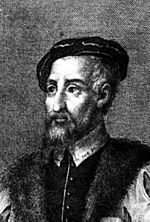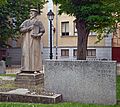Andrés Laguna facts for kids
Quick facts for kids
Andrés Laguna
|
|
|---|---|

Andrés Laguna
|
|
| Born | 1499 |
| Died | 1559 |
| Nationality | Spanish |
| Scientific career | |
| Fields | botany pharmacologist |
Andrés Laguna de Segovia (1499–1559) was a Spanish doctor, scientist, and plant expert. He was known for his knowledge of plants and medicines. He lived during the Renaissance, a time when many people were interested in learning new things.
Biography
Andrés Laguna was born in Segovia, Spain, in 1499. His father was also a doctor. Andrés started his studies in Salamanca, then moved to Paris in 1530. There, he studied medicine and learned old languages like Greek and Latin. This helped him read ancient texts in their original form. He was also inspired by the famous thinker Erasmus.
In 1536, Laguna returned to Spain. He then traveled to England and lived in the Netherlands for some years. During his travels, he collected plants. He wanted to check if the old medical recipes from Dioscorides really worked.
From 1540 to 1545, he worked as a doctor in Metz. Then, from 1545 to 1554, he lived in Italy. He earned a special degree from the University of Bologne. Important leaders like Popes Paul III and Julius III honored him. He even became the doctor for Pope Julius III.
Laguna returned to Spain in 1557 after another three years in the Netherlands. He served as a doctor for the kings Charles V and Philip II. He also helped create the Botanical Garden of Aranjuez. He passed away in 1559, likely in Guadalajara, Spain. He was buried in Segovia.
What He Did
Andrés Laguna was a true "Renaissance man." This means he was good at many different things. He wrote about history, philosophy, politics, and medicine.
His most famous work is his translation of Materia Medica by Dioscorides. This old book was about plants and medicines. Laguna translated it into Spanish. He also added his own notes and ideas, which made the book much longer. He checked the original Greek texts and corrected mistakes.
Laguna's book was published in 1554. He personally tested many of Dioscorides's recipes. He added his own experiences as a plant and medicine expert. He had gathered herbs from all over Europe. His translation was very clear and useful. It became very popular and was reprinted many times. It was more helpful than other old medical books because it was very practical.
Laguna believed in some older medical ideas, like the "four humors." But he was also careful about new ideas like alchemy. He only believed things that could be proven. He sometimes wrote about new plants from the Americas, like guaiacum, which was used to treat illnesses.
His Writings
Andrés Laguna translated and wrote many books. Here are some of his important works:
- Translations and Commentaries:
* Pedanius Dioscorides of Anazarbus (1555): His famous translation of Dioscorides's book on plants and medicines. * The Four Most Elegant and Grave Orations of Cicero against Catiline: A translation of speeches by a Roman speaker. * Dialogues of Lucian of Samosata: Translations of ancient Greek stories. * Works by Aristotle and Galen: Translations of important philosophical and medical texts.
- Original Works:
* A Brief Discourse on the Cure of and Preservation from the Plague: In this book, he shared his ideas on how to treat and prevent the plague. He suggested that doctors should specialize in this disease. He also recommended certain treatments, like using specific plant infusions. * Europe the Self-Tormentor: This book, published in 1543, was about peace in Europe. He believed that Europe was hurting itself with wars. He wanted people to be more tolerant and focus on common principles. * He also wrote about the life of Galen and a book on how to measure medicinal ingredients.
Laguna published more than 30 works in total.
Images for kids
See also
 In Spanish: Andrés Laguna para niños
In Spanish: Andrés Laguna para niños




